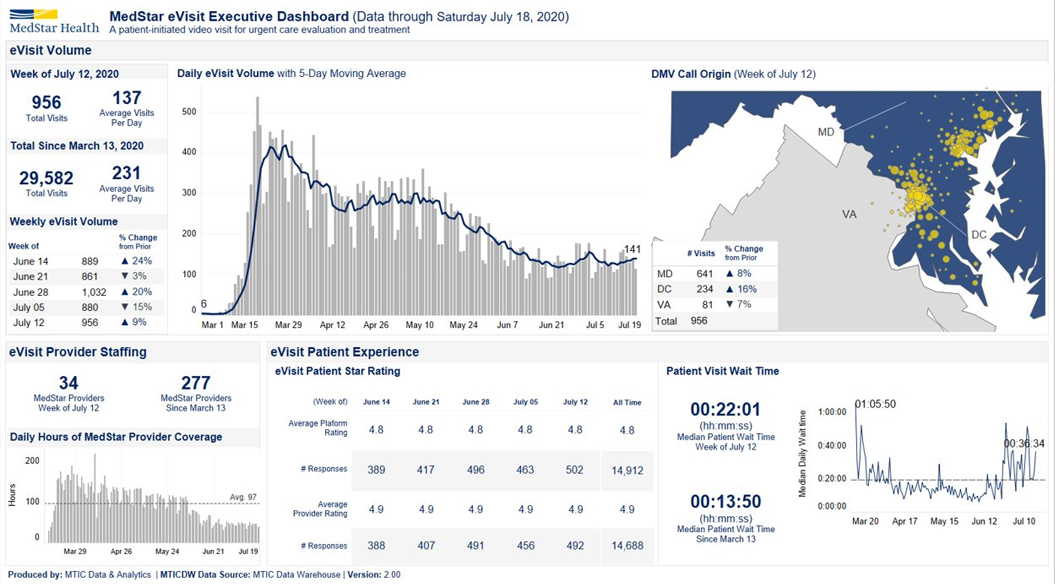
MedStar Health’s telehealth, human factors, and research teams authored two recently-published research articles to share lessons learned while helping the system navigate telehealth’s exponential growth during the COVID-19 pandemic.
Most recently, on July 23, 2020, the Journal of Telemedicine and Telehealth published “A descriptive analysis of an on-demand telehealth approach for remote COVID-19 patient screening,” by MedStar Health’s Raj Ratwani, PhD; David Brennan; Bill Sheahan; Allan Fong; Katharine Adams; Allyson Gordon; Mary Calabrese; Elizabeth Hwang; Mark Smith, MD; and Ethan Booker, MD.
Underscoring howon-demand telehealth helps effectively respond to COVID-19, the team analyzed 9,270 patient on-demand telehealth requests, the majority of which were found to likely be COVID-19 related. Importantly, 42% of patients who completed a related telehealth session stated they would've otherwise sought in-person care and 9% said they wouldn’t have pursued care without this option, among other findings about how telehealth helped patients, providers, and communities. This research increases the data available to demonstrate on-demand telehealth is a productive and low-barrier approach to screening patients for COVID-19.
Earlier this month, on July 3, the Journal of the American Medical Informatics Association published “Case Report: Rapid Development of Visualization Dashboards to Enhance Situation Awareness of COVID-19 Telehealth Initiatives at a Multi-Hospital Healthcare System,” authored by MedStar Health’s Ram Dixit; Stephen Hurst; Katharine Adams; Christian Boxley; Kristi Lysen-Hendershot; Sonita Bennett; Ethan Booker, MD; and Raj Ratwani, PhD.
The report details the five-step process the team employed to quickly design and deliver user-centered visualization dashboards supporting MedStar Health’s COVID-19 telehealth response, helping improve both situational awareness and operations. Examples of critical information featured on the dashboards include patient telehealth session volumes and wait times, patient and provider experience ratings, and telehealth platform performance statistics, with the dashboards serving three distinct stakeholder groups. Insights shared can help inform similar efforts within the broader healthcare community.
These MedStar Health teams have a unique window into scaling telehealth offerings during the pandemic, making their contributions to healthcare research both important and powerful. As of mid-July, MedStar Health had delivered more than 305,500 telehealth sessions during the COVID-19 pandemic. MedStar eVisit, on-demand urgent care by video, offered 24/7/365, drove about 10% of the volume with more than 29,500 sessions since the March 13 COVID-19 response start. MedStar Health Video Visits, scheduled video appointments with primary care and specialty providers—a platform built and launched at scale in just days during the pandemic—now drives about 83% of telehealth volume with more than 253,600 scheduled outpatient video visits delivered since the service’s March 23 launch. MedStar eConsults, inpatient/facility-based telehealth connecting providers to one another and patients, and patients to families, comprised the remaining roughly 7% of the total with more than 22,400 sessions since March 13.
Stay tuned for additional telehealth research expected in the coming months.
Categories
Media Contact
Marianne Worley
410-772-6661
202-531-1508 (cell)
marianne.worley@medstar.net
Brendan McNamara
410-772-6557
202-394-2430 (cell)
brendan.t.mcnamara@medstar.net









